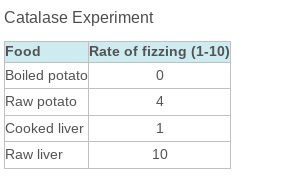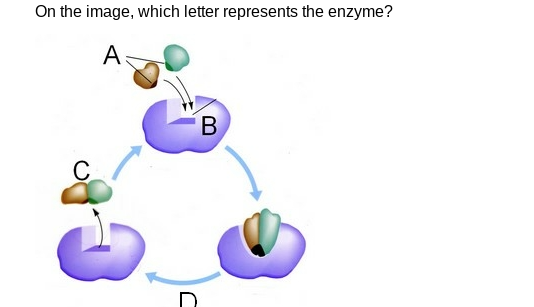Biology Final: Unit 2
5.0(2)
Card Sorting
1/34
Study Analytics
Name | Mastery | Learn | Test | Matching | Spaced |
|---|
No study sessions yet.
35 Terms
1
New cards
A substance that speeds up the rate of a chemical reaction is called
a catalyst
2
New cards
Which of the following statements about enzymes is NOT true?
* Enzymes work best at a specified pH.
* b. Enzymes are proteins.
* c. The shape of an enzyme allows it to do its job.
* All enzymes have the same shape as their substrates
* Enzymes work best at a specified pH.
* b. Enzymes are proteins.
* c. The shape of an enzyme allows it to do its job.
* All enzymes have the same shape as their substrates
d. All enzymes have the same shape as their substrates.
3
New cards
Amylase increases the rate at which starch is broken down into glucose. What kind of molecule is amylase?
enzyme
4
New cards
what changes would have an impact on the activity of an enzyme?
* Increase in pH
* Decrease in pH
* Increase in Temperature
* Decrease in Temperature
* Decrease in pH
* Increase in Temperature
* Decrease in Temperature
5
New cards
Which of the following makes up a molecule of water?
two atoms of hydrogen and one atom of oxygen
6
New cards
What are found in the space surrounding the nucleus of an atom?
electrons
7
New cards
With what 3 letters do enzymes typically end?
\-ase
8
New cards
The part of the enzyme where the substrate binds is called the:
active site
9
New cards
Electrically neutral atoms have equal numbers of __________ and __________.
electrons, protons
10
New cards
What is the term for the attraction of water molecules to other water molecules?
cohesion
11
New cards

The table above shows the results of an experiment done by Juan and Cindy. Juan and Cindy placed hydrogen peroxide on several food samples and recorded the relative amount of fizz that each produced. The fizz was produced by oxygen bubbles released by the action of the enzyme catalase, which is found in almost every living cell. Which of these is a valid conclusion from their data?
Raw liver produced the most oxygen bubbles, followed by raw potato
12
New cards
Which of the following is NOT a function of proteins?
* a. help to fight disease
* b. control the rate of reactions
* c. move substances into or out of cells
* d. store and transmit genetic information
\
* a. help to fight disease
* b. control the rate of reactions
* c. move substances into or out of cells
* d. store and transmit genetic information
\
store and transmit genetic information
13
New cards
A map of eastern North America, showing the pH of rainfall in the various states, indicates that the pH of rain in New York State varies from 4.22 to 4.40. According to these figures, the most acidic rainfall in New York State has a pH of
4\.22
14
New cards
Identify each of the following as being a property of an acid or a base.
1\.Usually has a sour taste
2\. Can feel slippery/soapy
3\. Corrodes metals and other materials
4. Bitter, chalky taste
5\. Measures above 7 on the pH scale
6\. Measures below 7 on the pH scale
1\.Usually has a sour taste
2\. Can feel slippery/soapy
3\. Corrodes metals and other materials
4. Bitter, chalky taste
5\. Measures above 7 on the pH scale
6\. Measures below 7 on the pH scale
1. acid
2. base
3. acid
4. base
5. base
6. acid
15
New cards
Which of the following is NOT a monomer?
a protein
16
New cards
Match the following items with the correct macromolecule found in living organisms.
1. Carries genetic information
2. Enzymes that help speed up chemical reactions
3. Used as the main source of long term energy
4. Glucose, sucrose, and cellulose
5. DNA or RNA
6. Starches and sugars
7. Fats, oils, and waxes
8. Monomer is a nucleotide
9. A main component of cell membranes
1. Carries genetic information
2. Enzymes that help speed up chemical reactions
3. Used as the main source of long term energy
4. Glucose, sucrose, and cellulose
5. DNA or RNA
6. Starches and sugars
7. Fats, oils, and waxes
8. Monomer is a nucleotide
9. A main component of cell membranes
1. nucleic acids
2. proteins
3. lipids
4. carbohydrates
5. nucleic acisd
6. carbohydrates
7. lipids
8. nulei acids
9. lipids
17
New cards
isotopes are atoms of the same element with the same number of protons and a different number of
neutrons
18
New cards
Which macromolecule stores energy, insulates us, and makes up the cell membrane?
lipids
19
New cards
The three particles that make up atoms are
a. protons, neutrons, and electrons.
20
New cards

Based on the graph, what temperature is optimum for this enzyme?
30 degrees celsius
21
New cards
All BUT one of the conditions listed will increase the reaction rate of an enzyme. The condition that will NOT increase the reaction rate is
* a. reaching ideal pH.
* b. reaching ideal temperature.
* Selected:c. increasing the acidity of the enzyme's environment.This answer is correct.
* d. increasing the amount of enzyme present
* a. reaching ideal pH.
* b. reaching ideal temperature.
* Selected:c. increasing the acidity of the enzyme's environment.This answer is correct.
* d. increasing the amount of enzyme present
increasing the acidity of the enzyme's environment.
22
New cards
Human blood has a pH between 7.35 and 7.45. Which of the following best describes human blood?
slightly basic
23
New cards
Match the following terms with the correct definition
1. matter
2. atom
3. molecule
4. ion
5. isotope
6. atomic number
1. matter
2. atom
3. molecule
4. ion
5. isotope
6. atomic number
1. anything that has massa nd takes up sapce
2. the basic unit of matter
3. two or more atoms joined together
4. an atom taht ahs a charge
5. an atom of the same elment wiht a diffrent number of neutrons
6. represents the number of protons and element contains
24
New cards
Amino acid is to protein as
simple sugar is to starch
25
New cards
Chemically speaking, enzymes are composed of chains of _________________, and they are considered to be a type of __________________.
amino acids, protein
26
New cards
Which statement is true about macromolecules?
. Proteins are made of amino acids.
27
New cards
Which of the following is a substance formed by the chemical joining of two or more elements in definite amounts?
compound
28
New cards
Enzymes affect the reactions in living cells by changing the
speed of the reaction
29
New cards
A substance with a pH of 6 is called
an acid
30
New cards
An atom of carbon has 6 protons and 7 neutrons in its nucleus. If the atom is neutral, how many electrons does it have?
6
31
New cards

On the image, which letter represents the enzyme?
B
32
New cards
In a water molecule, shared electrons spend more time around the oxygen atom than the hydrogen atoms. As a result, the oxygen atom is
slightly negative
33
New cards
All organic compounds contain the element
carbon
34
New cards
35
New cards
Which of the following is NOT one of the four most abundant elements found in living things
phosphorus